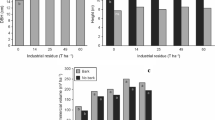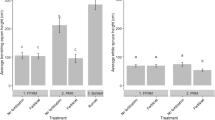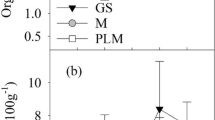Abstract
Growth and yield of 12-year-old loblolly pine (Pinus taeda L.) plantations were compared among five subsoil textures, seven site preparation methods, with and without phosphorus fertilizer. Phosphorus broadcast before planting increased the mean size of the loblolly pine trees. However, soil differences significantly influenced stand survival, and the method of site preparation significantly affected total stand yield. Therefore, the influence of phosphorus on total stand yield depended on soil type and site preparation method. The site preparation-fertilizer combinations yielding the most volume per soil type were: on the Lucy, Ruston, and Wagram soils, shear-windrow site preparation with phosphorus; on the Kirvin and Shubuta soils, chop-burn-harrow site preparation without phosphorus; on the Calloway and Henry soils, double chopping without phosphorus; on the Sawyer soil, chopburn-harrow site preparation with phosphorus; and on the Boswell, Cadeville, Gore, and Susquehanna soils, shear-windrow-harrow site preparation without phosphorus. Soil differences and phosphorus fertilization influenced the incidence of fusiform rust in 12-year-old stands of loblolly pine.
Similar content being viewed by others
References
Allen, H. L. 1987. Forest fertilizers. J. For. 85 (2): 37–46.
Baldwin, V. C., Jr. and Feduccia D. P. 1987. Loblolly pine growth and yield prediction for managed West Gulf plantations. USDA For. Serv., South. For. Exp. Sta., New Orleans, Louisiana. Res. Pap. SO-236.
Cain, M. D. 1985. Long-term impact of hardwood control treatments in mature pine stands. USDA For. Serv., South. For. Exp. Sta., New Orleans, Louisiana. Res. Pap. SO-214.
DeWit, J. N. and Terry, T. A. 1983. Site preparation effects on early loblolly pine growth, hardwood competition, and soil physical properties. In: Jones, E., Jr. (Ed) Proceedings: 2nd Bienn. South. Silvicultural Res. Conf., 4–5 November 1982. Atlanta, Georgia. pp. 40–47.
Gent, J. A.Jr., Allen, H. L. and Campbell, R. G. 1986. Phosphorus and nitrogen plus phosphorus fertilization in loblolly pine stands at establishment. South. J. Appl. For. 10: 114–117.
Glover, G. R. and Dickens, D. F. 1985. Impact of competing vegetation on yield of the southern pines. Georgia Forestry Commission, Research Division. Res. Pap. 59.
Langdon, O. G. and Trousdell, K. B. 1974. Increasing growth and yield of natural loblolly pine by young stand management. In: Williston, H. L. and Balmer, W. E. (Eds) Proceedings: Symposium on management of young pines, 22–24 October 1974. Alexandria, Louisiana, 3–5 December 1974. Charleston, South Carolina. pp. 288–296.
McClurkin, D. C. and Moehring, D. M. 1978. Consequences of site disturbances in the Upper Coastal Plain. In: Tippen T. (Ed) Proceedings: A symposium on principles of maintaining productivity on prepared sites. 21–22 March 1978. Mississippi State University, MS. and USDA For. Serv., Southeast. Area State and Private Forestry, Atlanta, Georgia. pp. 73–84.
Moehring, D. M. 1970. Forest soil improvement through cultivation. J. For. 68: 328–331.
Pehl, C. E. 1984. Residual effects of site preparation on growth and surface soil properties of Pinus taeda L. plantations. For. Ecol. Manage. 9: 1–11.
Pehl, C. E. and Bailey R. L. 1983. Performance to age ten of a loblolly pine plantation on an intensively prepared site in the Georgia Piedmont. For. Sci. 29: 96–102.
Pritchett, W. L. 1976. Phosphorus in forest soils. Phosphorus in Agric. 67: 27–35.
Schmidtling, R. C. 1984. Early intensive culture affects long-term growth of loblolly pine trees. For. Sci. 30: 491–498.
Slay, J. M., Lockaby, B. G., Adams, J. C. and Vidrine, C. G. 1987. Effects of site preparation on soil physical properties, growth of loblolly pine, and competing vegetation. South. J. Appl. For. 11: 83–86.
Stransky, J. J., Roese, J. H. and Watterston, K. G. 1985. Soil properties and pine growth affected by site preparation after clearcutting. South. J. Appl. For. 9: 40–43.
Tiarks, A. E. and Haywood, J. D. 1986. Pinus taeda L. response to fertilization, herbaceous plant control, and woody plant control. For. Ecol. Manage. 14: 103–112.
Wolters, G. L., Martin, A., Jr. and Clary, W. P. 1977. Timber, browse, and herbage on selected loblolly-shortleaf pine-hardwood forest stands. USDA For. Serv., South. For. Exp. Sta., New Orleans, Louisiana. Res. Note SO-223.
Author information
Authors and Affiliations
Rights and permissions
About this article
Cite this article
Haywood, J.D., Burton, J.D. Phosphorus fertilizer, soils, and site preparation influence loblolly pine productivity. New Forest 3, 275–287 (1989). https://doi.org/10.1007/BF00030037
Received:
Accepted:
Issue Date:
DOI: https://doi.org/10.1007/BF00030037




